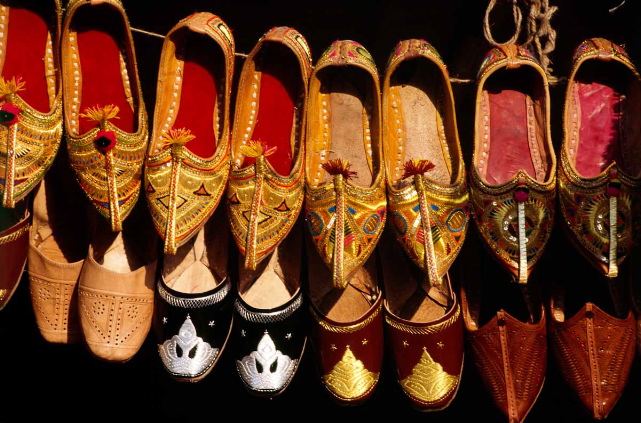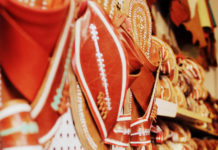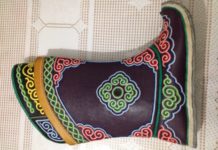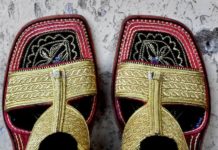Climate, ethnicity, gender, age, status and other factors have influenced the diverse footwear traditions across India. Shoe-making is an oral and hereditary tradition. It involves varied materials, including precious and non-precious metal, wood, leather and grass. Shoes are distinguished by their shapes, usage, decorative elements and finishing. Footwear types have included the toe-knob sandals crafted for mendicants and holy men. The pulla chaapal is woven of cannabis grass that is worn in the snow. One of the many diverse traditions is that of the tilla juttis from the Punjab.
 Juttis are shoes with a closed upper attached to a flat sole with no left or right foot distinction. They allow for customisation by the wearer and are traditional footwear in North India. Also known as khussa or mojri, they are hand-stitched in leather with no nails used. The speciality of the Punjab juttis is the customisation of the uppers and insoles with hand-stitched metallic yarns of gold and silver (tilla).
Juttis are shoes with a closed upper attached to a flat sole with no left or right foot distinction. They allow for customisation by the wearer and are traditional footwear in North India. Also known as khussa or mojri, they are hand-stitched in leather with no nails used. The speciality of the Punjab juttis is the customisation of the uppers and insoles with hand-stitched metallic yarns of gold and silver (tilla).
The tilla juttis are made in various parts of Punjab, each with their own specific variant. The most well-known is the Patiala tradition of the khussa tilla jhutti where the toe is curled and upturned to a sharp–tip. The other variants are the Malerkotia tilla juttis known for the fine dense embroideries of trellis, wave and rhombus patterns; the Firozepur variant that are patterned in checks; while other centres across Punjab differ in both the type of patterning and their use of myriad coloured metallic yarns.
The soles of this hard wearing and sturdy footwear are constructed of buffalo hide. The cowhide used for the uppers is processed using vegetable tanning method. In this home-based craft, the cutting and stitching is undertaken by men while the women embroider the uppers. Earlier worn only by wealthy landowners, the tilla juttis are now the footwear of choice across Punjab.





